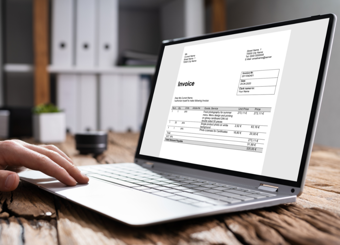Why your AP process is key to successful strategic sourcing
The source to payment process is often described as a linear process, starting with sourcing followed by procurement and ending with payment. However, this description fails to illustrate the essential feedback loop that goes from payment into the strategic sourcing process. The truth is payment is not just the end of the process. It is the start of an opportunity to improve the strategic sourcing flow. Without complete, accurate and detailed line item invoice information, key steps in the process will be challenging to perform.
It is time to upgrade the value of a high-performing accounts payable process and discover how knowledgeable AP professionals can improve your sourcing and procurement process flow.
Know your numbers, control your business!
The phrase "scientia potentia est" (or "scientia est potentia" or also "scientia potestas est") is a Latin aphorism meaning "knowledge is power.” This phrase is especially true when it comes to the power game in the business relationships between procurement and suppliers.
Accounts Payable’s Role in the Strategic Sourcing Process

A strategic sourcing process starts with a spend analysis and (savings) opportunity identification and ends with an agreement implementation. And whether you use a 5-, 6- or 7-step strategic sourcing process, it will cover the steps:
- Identify and prioritize sourcing opportunities
- Internal and external category profiling and analysis of Total Cost of Ownership (TCO)
- Analysis of most suitable sourcing strategy and go-to-market approach
- Identify supplier selection criteria and create evaluation model, prepare specifications and other RFP documentation, identify supplier long list and issue RFP
- Evaluate proposals, define negotiation tactics, negotiate and finalize the agreement
- Implement and communicate agreement in the organization
Consider step 2 to understand why a back-office and operational processes such as accounts payable may be more important than you think to succeed with strategic sourcing. This step is fundamental to the success of the following steps, and it is the step where the completeness, accuracy, and detail of the invoice data in the accounts payable process is in focus.
Unveiling the Category Baseline
The second step includes two main activities/analyses:
- Understand internal profile including Total Cost of Ownership
- Understand external market factors
In the second activity, the sourcing team needs to understand external market factors and industry trends. In this analysis, sourcing teams often find themselves depending on external sources, so data quality and review can be challenging.
Surprisingly, creating the category internal profile often turns out to be equally challenging – even though the internal profile is based on procurement spend data that the company (supposedly) controls! The sourcing team needs to answer three main questions to understand the internal category profile.
- What are we buying? Which items to what price and in what volumes?
- From whom are we buying? Which suppliers make up the majority of our spend?
- And in what way are we buying it? How are we buying it (process), what is the order frequency, seasonal variations, payment terms, discounts, etc.
If you cannot answer these fundamental questions, how would you know what requirements to put in the RFP? And how would you ever be successful in negotiations with the suppliers?
The Challenge: Access to Complete, Accurate & Detailed Invoice Data
When analyzing the invoice data, sourcing teams often find examples where POs and contract references are missing, invoices are captured on header and not item level giving little transparency into what the actual items/services are, discounts are applied on totals and not distributed to item level, freight is included in price and not separated from the item price, and so on. The root cause for this low data quality is a manual or semi-automated P2P process.
Sourcing teams have learned to find workarounds to poor spend transparency - for example, sample analyses of actual invoices captured on header level and use of freight and volume proxies. But workarounds like these are time-consuming and seldom provide the accuracy needed to truly understand the category internal profile. An extreme example of workaround is when the procurement department has added clauses into the terms and conditions of the purchasing agreement stating that the supplier is required to provide the buyer with purchasing data! Because you can be sure that the suppliers you engage with have full item level transparency on their side to bill you. And this raises the initial question of who is in control of your numbers and business.
Using the AP Automation Solution as Data Hub
As you can see, the success of your spend analysis is dependent on the reliability of your data invoice capture, which is where a robust accounts payable solution comes into play. Automated AP technology does what EDI, e-invoicing and supplier portals cannot do: capture complete, accurate and detailed data from invoices in any format, offering total transparency into how you’re spending your money while minimizing errors and reducing dependence on outside vendors.
Armed with full spend transparency you have all the information you need to move with confidence to the next stage in the strategic sourcing process: determining the suppliers that best meet your operational needs. This can be done via eSourcing - which involves using a single online portal to obtain bids from different suppliers via a single online portal - or manually.
When your AP professionals can support the strategic sourcing teams with full spend visibility, they in their turn can spend more time analyzing the external market factors and craft the optimal sourcing and negotiation strategy. This increases the likelihood of strategic sourcing generating significant business value. At this point, you - not your suppliers - control your business relationship






